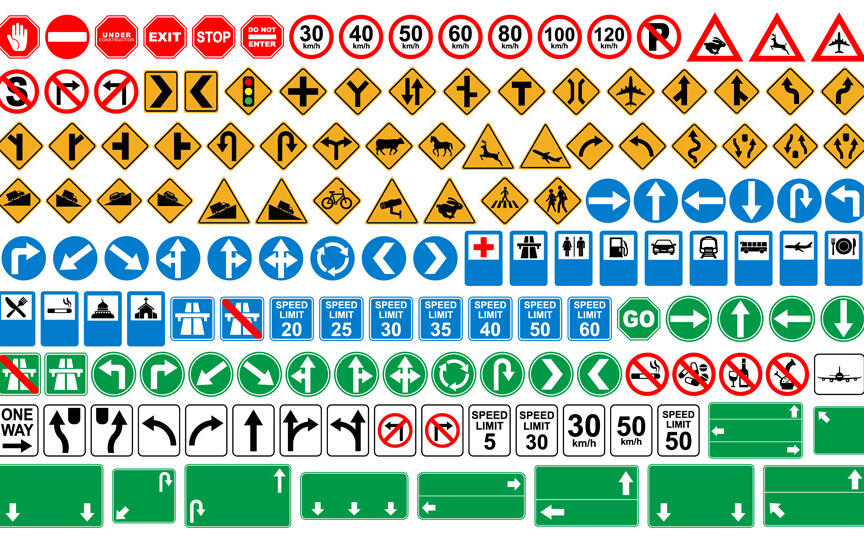Navigating the Language of the Road: A Guide to Understanding Road and Traffic Signage
Welcome to our comprehensive guide on the fascinating world of road and traffic signage! As drivers, cyclists, or even pedestrians, we encounter a myriad of signs every day – each a crucial piece in the complex puzzle of road safety. But how often do we pause to truly understand these silent guardians of the road?
Road and traffic signs are more than mere symbols; they are the universal language of safe travel, transcending borders and linguistic barriers. In this article, we will embark on a journey to decode this language, delving into the meanings behind common road signs and traffic management symbols that guide, warn, and inform us during our travels.
Understanding these signs is not just a matter of legal compliance; it's a cornerstone of road safety. Misinterpreting a sign or missing one altogether can lead to dangerous situations, both for the driver and others on the road. This guide aims to sharpen your awareness and appreciation of these vital indicators, ensuring a safer journey for all.
We'll explore the history, types, and significance of various road signs, shedding light on their crucial role in traffic management and safety. From the familiar stop sign to the lesser-known but equally important informational signs, each plays a pivotal role in guiding us safely from point A to point B.
So, buckle up and prepare for an enlightening ride through the world of road and traffic signage. Whether you're a seasoned driver or a newcomer to the roads, this guide promises to enhance your understanding and help you navigate the roads with greater confidence and safety.
Tracing the Roots: The History and Importance of Road Signs
The story of road signs is a fascinating journey through history, reflecting the evolution of transportation and societal needs. The earliest known road signs date back to the Roman Empire, where stones called "milliaries" were placed along roads to indicate distances to various destinations. This rudimentary form of signage was the precursor to the comprehensive system we know today.
The Industrial Revolution marked a significant turning point. The surge in road traffic due to the advent of bicycles and motor vehicles necessitated a more structured approach to road signage. In the early 20th century, as cars became more widespread, the need for standardisation became increasingly apparent. The 1908 International Road Congress in Rome was a pivotal moment, where countries began to discuss the need for uniform road signs.
The importance of road signs cannot be overstated. They play a vital role in ensuring the smooth flow of traffic and significantly reducing the likelihood of accidents. Road signs provide essential information, warn of potential hazards, and give instructions that must be obeyed for safety. Without them, navigating the roads would be chaotic and perilous.
One of the key functions of road signs is to convey messages quickly and unambiguously to drivers who may not share a common language. This is achieved through the use of universally recognised symbols and colours. For instance, red commonly indicates prohibition or warning, while blue usually denotes informational signs.
The design and placement of road signs are also crucial. They must be visible, understandable, and able to convey the message in a split second. This requires a deep understanding of human psychology and behaviour. Signage that fails to meet these criteria can lead to confusion and accidents.
Furthermore, road signs have legal implications. Ignorance of road signs is not considered a valid defence in traffic violations. Compliance with these signs is not only a matter of courtesy but a legal requirement in most countries.
Road signs are a vital component of road safety. They have evolved from simple milestones to a sophisticated system of communication that is essential for the safe and efficient movement of traffic. As technology advances, so does the complexity of our road networks, making the role of these signs more crucial than ever. Understanding their history and importance is key to appreciating their role in our daily commutes and long journeys alike.
Decoding the Signals: Types of Road Signs
Road signs are the silent sentinels of the road, each type serving a specific purpose in guiding, warning, and informing road users. Broadly categorised into three main types – Regulatory, Warning, and Informational – these signs are integral to road safety and efficient traffic management. Let's explore each category in detail:
1. Regulatory Signs:
These signs are the law enforcers of the road. They are designed to communicate the rules that must be followed for the safety and order of traffic. Regulatory signs are generally circular and are further divided into two categories:
- Mandatory Signs: Usually circular with a blue background, these signs dictate specific actions that drivers must adhere to, such as 'Turn Left', 'Keep Right', or speed limits.
- Prohibition or Restrictive Signs: Recognisable by their red circle with a diagonal line, these signs indicate certain actions or behaviours that are not permitted, like 'No Entry', 'No U-Turn', or 'No Parking'.
2. Warning Signs:
As the name suggests, warning signs are meant to alert drivers of potential dangers or unusual conditions ahead. They are usually diamond-shaped or triangular with a red border and include a black pictogram on a yellow or white background. These signs are critical as they prepare drivers for what lies ahead, allowing them to take precautionary measures. Common examples include 'Bend Ahead', 'Pedestrian Crossing', and 'Slippery Road'.
3. Informational Signs:
Informational or guide signs provide useful data about routes, directions, distances, services, points of interest, and facilities. They are generally rectangular and come in various colours:
- Directional and Place Identification Signs: Usually in blue or green, these signs guide the driver along routes, indicating distances and directions to various locations or landmarks.
- Service Signs: Found in blue, these signs indicate the availability of facilities like petrol stations, hospitals, rest areas, and more.
- Tourist Information Signs: These signs, often brown, point towards cultural attractions, historical sites, and natural landmarks.
Understanding these types of signs is crucial for navigating the roads effectively and safely. They not only assist in decision-making but also enhance the driving experience by reducing uncertainty and stress.
In summary, road signs, in their various forms, are the unsung heroes of road safety, silently guiding millions of road users every day. Familiarity with these signs not only ensures compliance with the law but also contributes to a safer and more pleasant journey.
Mastering the Art of Navigation: Understanding Traffic Management Signs
Traffic management signs play a pivotal role in guiding drivers and ensuring the smooth flow of traffic, particularly in areas of construction, special events, or other disruptions. These signs are essential for both safety and efficiency on the roads. Here, we delve into the various types of traffic management signs and their significance:
Temporary Traffic Control Signs:
These signs are crucial during road construction or maintenance works. They guide drivers safely around work zones, minimising confusion and risk of accidents. Typically, they are fluorescent orange and instantly recognisable. Examples include:
- "Men at Work" Sign: Indicates that construction or maintenance is in progress.
- Detour Signs: Used to direct traffic away from the closed or hazardous section of the road.
- Road Machinery Ahead: Warns drivers about the presence of heavy machinery on or near the road.
Incident Management Signs:
These signs come into play during unexpected events like accidents, natural disasters, or other emergencies. Their primary goal is to ensure an orderly flow of traffic around the incident area. Examples include:
- "Accident Ahead" Sign: Alerts drivers to slow down and be prepared for potential stoppages or diversions.
- "Emergency Scene Ahead" Sign: Informs drivers of an ongoing emergency operation and the need for heightened caution.
Event Management Signs:
Used during special events that significantly alter normal traffic patterns, these signs help manage the increased traffic flow and ensure pedestrian safety. They're often temporary and specific to the event. Examples are:
- "Event Parking" Sign: Directs drivers to designated parking areas for a specific event.
- "Pedestrian Crossing" Sign: Alerts drivers to high pedestrian activity during events, necessitating extra caution.
Lane Management Signs:
In urban areas and on motorways, lane management signs are used to control the flow of traffic, especially during peak hours. These signs can be permanent or variable and are crucial for avoiding bottlenecks. Examples include:
- Lane Closure Signs: Indicate that one or more lanes are closed ahead.
- Variable Message Signs (VMS): These electronic signs provide real-time information about traffic conditions, lane availability, and speed limits.
Understanding these traffic management signs is vital for drivers, as they directly impact journey times and safety. By following these signs, drivers contribute to a safer and more efficient road environment, especially in situations where usual traffic patterns are altered.
Traffic management signs are not just mere indications; they are essential tools for maintaining order and safety on the roads. Their proper interpretation is a skill every road user should master, ensuring a harmonious and safe travel experience for all.
Deciphering the Palette: Colour and Shape Codes of Irish Road Signs
In Ireland, as in many countries, the colour and shape of road signs are not arbitrary choices; they are meticulously designed to convey specific meanings and instructions. This systematic use of colours and shapes ensures that drivers can quickly interpret vital information, even at a glance. Let's dive into the significance of these colour and shape codes in Irish road signage:
Colour Codes:
- Red: Universally recognised as the colour of stop and prohibition, red is used in signs like 'Stop', 'No Entry', and 'Prohibited Turns'. Red borders are also commonly found in warning signs.
- Blue: Indicating mandatory instructions or services, blue is used in signs such as 'Ahead Only' or 'Turn Left', and for informational signs like parking areas or hospitals.
- Yellow/Amber: This colour, often seen in diamond-shaped signs, is primarily associated with warning signs. It signals caution, highlighting hazards such as roadworks, bends, or low bridges.
- Green: Green is typically used for direction signs on national roads, signifying go or providing information about destinations and distances.
- White: Employed mostly for regulatory signs, white backgrounds with black lettering or symbols indicate speed limits, no parking, and other regulations.
- Brown: Used for tourist information and site indications, such as historical landmarks, picnic areas, and scenic routes.
Shape Codes:
- Circular: Circular signs primarily indicate prohibitions (red circle with a diagonal line) or mandatory actions (blue circle). These are immediate commands or restrictions.
- Triangular: Triangular signs, with their pointed edge facing upwards and a red border, are predominantly warning signs. They alert drivers to potential hazards ahead, such as junctions, pedestrian crossings, or animals on the road.
- Rectangular or Square: These shapes are generally used for informational signs. They provide directions, regulations, or supplementary information, such as bus lanes, parking zones, or speed limits.
In Ireland, understanding these colour and shape codes is crucial for both safe driving and compliance with traffic laws. They are designed to be intuitive, allowing for quick and easy comprehension by drivers, irrespective of language barriers.
In conclusion, the colour and shape codes of Irish road signs are more than just design elements; they are essential visual cues that guide, warn, and inform drivers, contributing significantly to road safety. Familiarity with these codes is indispensable for anyone navigating the Irish roads, ensuring a safer journey for all road users.
A Global Language with Local Dialects: International Variations in Road Signage
Road signs, while following international conventions to a great extent, exhibit intriguing variations across different countries. These variations reflect a blend of global standardisation and local customisation, adapting to regional driving practices, cultural norms, and legal requirements. Exploring these international differences not only broadens our understanding but also prepares us for driving experiences in foreign lands.
Standardisation Efforts:
The 1968 Vienna Convention on Road Signs and Signals marked a significant step towards standardising road signs internationally. Many countries have adopted these guidelines, ensuring a level of uniformity, especially in signs' shapes and colours. For instance, stop signs are octagonal and red across most countries, and triangular signs universally denote warning.
Notable Variations:
- Colour Schemes: While red universally signifies stop or prohibition, and blue indicates mandatory actions or information, nuances exist. For example, in the United States, yellow is used for warning signs, whereas in Europe, it's primarily white or amber.
- Pictograms vs Text: Some countries rely heavily on pictograms for immediate recognition, while others, like the United States, often incorporate text into their signs. This can be a challenge for non-native speakers or travellers unfamiliar with the local language.
- Cultural Influences: Local customs and cultural aspects can influence sign design. For instance, signs in Japan may reflect local artistic styles, while European signs often have a more straightforward, universal design.
Regional Specifics:
- Europe: European road signs are largely homogenised due to the Vienna Convention. However, subtle differences exist, like the colour of direction signs (green for motorways, blue for other roads in many countries).
- North America: The U.S. and Canada have signs that are generally consistent with each other but distinct from European standards, especially in the use of text and measurement units (miles vs kilometres).
- Asia and Africa: These continents show greater diversity in road signage, influenced by local languages, alphabets, and driving practices. For example, Japan's signs are highly pictorial, whereas African countries might have unique signs indicating local wildlife crossing.
Understanding these international variations is crucial, especially in our increasingly interconnected world where cross-border travel is common. While the basic principles remain the same, these regional differences can impact how we interpret and respond to road signs.
While road signs serve a universal purpose, their execution varies globally. Recognising and respecting these international differences is key to safe and responsible driving in foreign countries. As global citizens and travellers, acquainting ourselves with these variations not only enhances our driving competence but also our appreciation of the diverse ways in which different cultures approach road safety.
Safety First: Tips and Legal Implications of Road Signs in Ireland
Road signs are not just indicators on our journey; they are crucial for ensuring safety and smooth traffic flow. In Ireland, adhering to these signs is not only a matter of safety but also of legal responsibility. This section delves into practical safety tips and the legal implications of road signs in Ireland, aiming to promote a culture of responsible and safe driving.
Safety Tips:
- Stay Informed: Familiarise yourself with the latest road signs and their meanings. New signs or updates to existing ones can occur, and staying informed is key.
- Observe and React: Always be alert to road signs and react accordingly. Whether it’s a stop sign, speed limit, or warning sign, timely compliance is crucial for safety.
- Adjust to Conditions: Road signs often reflect the conditions ahead. Adjust your driving accordingly, especially in response to warning signs about roadworks, school zones, or weather-related conditions.
- Respect Temporary Signs: Pay special attention to temporary signs, especially in construction zones or during events. These signs might indicate detours or special rules that are essential for safety and smooth traffic flow.
Legal Implications:
- Mandatory Compliance: Under Irish law, failing to comply with road signs is a traffic offence. This can result in penalties, including fines, penalty points, or even prosecution.
- Insurance Implications: Non-compliance with road signs can affect insurance claims. In the event of an accident, if it’s found that road signs were disregarded, insurance coverage might be impacted.
- Driving Licence Points: Certain offences related to ignoring road signs can lead to penalty points on your driving licence. Accumulating too many points can result in the suspension of your driving licence.
Importance of Compliance:
- Accident Prevention: Many accidents are caused by the failure to observe road signs. Compliance is essential to prevent collisions and ensure the safety of all road users.
- Pedestrian Safety: In urban areas and near schools, adherence to road signs is critical for the safety of pedestrians, especially children.
- Legal Responsibility: Drivers in Ireland are legally responsible for understanding and following road signs. Ignorance of the signs or their meanings is not a valid defence in traffic violations.
Road signs are a vital component of road safety in Ireland. They guide drivers, inform them of potential hazards, and regulate traffic flow. Adhering to these signs is not just about avoiding legal consequences; it’s about contributing to a safer road environment for everyone. As responsible drivers, understanding and respecting these signs should be an integral part of our driving habits.
The Journey’s End: Concluding Thoughts on Road and Traffic Signage
As we conclude our exploration into the world of road and traffic signage, it's evident that these signs do much more than merely decorate our roadsides. They are, in essence, the language of the road – a language that speaks of safety, guidance, and legal obligation. This journey through the various aspects of road signs, from their history and types to their colour and shape codes, and the crucial role they play in traffic management, underscores their importance in our daily travels.
The Role of Road Signs:
Road signs are the unsung heroes of road safety. They manage traffic flow, warn us of potential hazards, and inform us of essential regulations. Their universal language breaks down barriers, allowing people of all tongues to understand and follow the rules of the road.
Our Responsibility:
Understanding and adhering to these signs is a responsibility that falls on each of us as road users. Whether we are drivers, cyclists, or pedestrians, our actions on the road have implications not just for our safety but for the safety of others. We must be vigilant, observant, and respectful of the rules conveyed by these signs.
The Future of Road Signage:
As technology advances, we may see changes in how road information is conveyed. Digital signs, GPS-based alerts, and perhaps even AI-driven traffic management systems may become more prevalent. However, the fundamental principles of road signs, rooted in clarity, universality, and safety, will undoubtedly remain constant.
Let us all commit to being more attentive and responsive to these vital signs. Share this knowledge with new drivers, friends, and family. Together, we can contribute to safer roads and a better understanding of the indispensable role that road signs play in our lives.
In closing, road and traffic signs are more than mere instructions; they are the guiding lights that ensure our journeys are safe and regulated. As we navigate the roads, let’s appreciate these signs for the invaluable service they provide, guiding us safely to our destinations. Remember, every sign has a story, a purpose, and a life-saving message. It’s up to us to listen, understand, and act accordingly.
Join the Journey with Time for Designs
As we reach the end of our enlightening journey through the world of road and traffic signage, it's clear that knowledge and awareness are key to navigating the roads safely. At Time for Designs, we're not just about imparting information; we're about creating a community of well-informed, responsible individuals who value safety and innovation.
Let's Connect and Create:
- Share Your Thoughts: Did this guide enhance your understanding of road signs? Do you have any road sign experiences to share? We'd love to hear your stories and insights. Drop a comment below or engage with us on our social media platforms.
- Spread the Word: If you found this guide helpful, share it with your friends, family, and network. Let's spread awareness and contribute to safer roads for everyone.
- Collaborate with Us: At Time for Designs, we're always looking for collaborative opportunities. Whether you're an entrepreneur, an educational institution, or a safety advocate, let's join forces to create impactful projects and campaigns.
Embracing Innovation:
- Explore Our Services: Dive into the array of services we offer. From web design to innovative printing solutions, our expertise is vast and ready to meet your needs. Got a custom project in mind? Let’s talk.
- Stay Informed: Subscribe to our newsletter for the latest updates, tips, and exclusive offers. We promise to bring you content that's not just informative, but also inspiring.
Your Vision, Our Mission:
- Bring Your Ideas to Life: Have a unique idea or a challenging project? At Time for Designs, we thrive on turning visions into reality. Contact us to discuss how we can collaborate to bring your concept to fruition.
In joining hands with Time for Designs, you're not just choosing a service provider; you're becoming part of a community that values creativity, quality, and innovation. Let's make every journey on the road a safer one, and every creative vision a reality.
Together, we can create a brighter, safer, and more innovative future. Reach out to us today – let's drive change together!








Comments (0)
Add a Comment